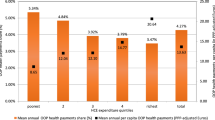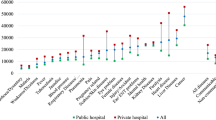Abstract
Currently, a high percentage of China’s households face financial catastrophe as a direct result of excessive out-of-pocket (OOP) health expenditures. To alleviate this, China has set up the Critical Illness Insurance (CII) program since 2012. However, the current CII is still in an experimental phase and tested in 8 (out of 34) provinces, which has not been proved to be effective. This paper develops a health financing system for reducing catastrophic medical spending using a two-layer model for CII. This model partly compensates expenses exceeding the cap line of the Social Resident Basic Medical Insurance scheme to maintain the ratio of OOP expenses to total medical expenditure approximately at 20%. Adjustment coefficients based on individual net income across different regions are applied to increase fairness. The financial sustainability of the model is tested using a fund balance calculation. Finally, the two-layer model of the CII is empirically simulated with the latest provincial data from China Family Panel Studies. The results demonstrate that the model can effectively alleviate the incidence and severity of catastrophic health expenditures.
Similar content being viewed by others
Explore related subjects
Discover the latest articles and news from researchers in related subjects, suggested using machine learning.Notes
On the condition of keeping the premium rate of the SRBMI unchanged.
In the international definition of catastrophic medical expenditure, the threshold is set at "40% of a household's capacity of pay" (Xu et al. 2003) i.e.,\( CAT = 40\% \times CTP \), where \( CTP \) represents the household capacity to pay, which could be measured by household non-food expenditures. Compared to China's standard, the international standard is at household level. As the SBMI in China is implemented at individual level, we use China's standard.
The type of reinsurance treaty that we consider in this model is “the excess of loss (per risk)”, one type of non-proportional reinsurance.
See “Appendix (b)” for more detailed information about \( OOP_{a} \).
There are several definitions of premiums during pricing process, for instance, risk premium, collective premium, credibility premium, pure premium and gross premium. The basic ideas behind these are "an equivalence principle" and "margins". In our analysis, we follow the main statistical steps of premium calculation (Migon and Moura 2005; Amin and Salem 2015). First, the pure premium is calculated based on the available past information concerning the number and the amount of losses and also the population exposed to risk. Second, the gross premium is represented by pure premium plus margins including a risk loading, expense and profit.
In general, a security surcharge can be calculated as 10%-30% of the pure premium (China Association of Actuaries 2011). In view of the high medical expense insurance pricing discussed in the paper, we set the security surcharge at 30%.
The deductible of the SRBMI is not considered here since it has little effect on the total medical insurance loss when \( X \in \left( {TL_{1} ,TL_{2} } \right) \).
The amount of deductible and compensation ratio is based on the policies of the SRBMI in China.
The values of \( \int_{CD}^{{TL_{1} }} {F\left( x \right)dx} \) and \( \int_{{TL_{1} }}^{{TL_{2} }} {F\left( x \right)dx} \) should be estimated by infinitesimal element method. According to Fig. 7, the cumulative distribution function of \( x \), the top of \( \int_{CD}^{{TL_{1} }} {F\left( x \right)dx} \) is an arc with larger radian. In addition, the more segmentation, the fewer errors in the process of approximate solving based on the regular graphics. Therefore, the approximate value is made available by segmenting it into several sections. When the gap between \( F\left( A \right) \) and \( F\left( B \right) \) is small, \( \int_{A}^{B} {F\left( x \right)dx} \approx \left( {B - A} \right) \times \left( {F\left( B \right) - F\left( A \right)} \right)/2 \).
References
Amin, Z., & Salem, M. (2015). Bayesian modelling of health insurance losses. Journal of Applied Statistics, 42(2), 231–251.
Berki, S. E. (1986). A look at catastrophic medical expenses and the poor. Health Affairs, 5(4), 138–145.
Bredenkamp, C., Mendola, M., & Gragnolati, M. (2011). Catastrophic and impoverishing effects of health expenditure: New evidence from the Western Balkans. Health Policy and Planning, 26, 349–356.
China Association of Actuaries. (2011). Health insurance. Beijing: China Financial Economic Publishing House.
China Health Statistical Yearbook, various years. (2013).
China Insurance Yearbook, various years. (2014).
China Statistical Yearbook, various years. (2014).
Kawabata, K., Xu, K., & Carrin, G. (2002). Preventing impoverishment through protection against catastrophic health expenditure. Bulletin of the World Health Organization, 80(8), 612.
Kraay, A. (2000). Household saving in China. World Bank Economic Review, 14(3), 545–570.
Migon, H. S., & Moura, F. A. S. (2005). Hierarchical Bayesian collective risk model: An application to health insurance. Insurance: Mathematics and Economics, 36, 119–135.
Rothschild, M., & Stiglitz, J. (1976). Equilibrium in competitive insurance market: An essay on the economics of imperfect information. Quarterly Journal of Economics, 4, 629–649.
Sun, X. Y., Jackson, S., Carmichael, G., & Sleigh, A. C. (2009). Catastrophic medical payment and financial protection in rural China: Evidence from the new cooperative medical scheme in Shandong province. Health Economics, 18(1), 103–119.
The State Council of China. (2012). Guidance on carrying out the work of Critical Illness Insurance for urban and rural residents in China.
Verlaak, R., & Beirlant, J. (2003). Optimal reinsurance programs: An optimal combination of several reinsurance protections on a heterogeneous insurance portfolio. Insurance: Mathematics and Economics, 33(2), 381–403.
Wagstaff, A., & Van Doorslaer, E. (2003). Catastrophe and impoverishment in paying for health care: With applications to Vietnam 1993–1998. Health Economics, 12(11), 921–934.
World Health Organization. (2010). Health systems financing: The path to universal coverage.
Xu, K., Evans, D. B., Carrin, G., Aguilar-Rivera, A. M., Musgrove, P., & Evans, T. (2007). Protecting households from catastrophic health spending. Health Affairs, 26(4), 972–983.
Xu, K., Evans, D. B., Kawabata, K., Zeramdini, R., Klavus, J., & Murray, C. J. L. (2003). Household catastrophic health expenditure: A multicountry analysis. The Lancet, 362, 111–117.
Xue, S. F., Guo, Z. Q., Jin, S. L., Cui, X. G., Ruan, Y. S., Qiao, H., et al. (2005). Medical expenses of New Rural Co-operative Medical System in the Ningxia Hui Autonomous Region. Chinese Health Economics, 3, 15–17.
Zhang, Y. (2014). A study on the cooperative mechanisms between social health insurance and private health insurance. Beijing: China Social Sciences Publishing House.
Zhu, M. L., Song, Z. J., & Wang, X. (2013). The interpretation and analysis of the compensation patterns for major illness medical insurance policies—An empirical study based on the hospitalisation data of residents in Tianjin. Insurance Studies, 1, 97–105.
Acknowledgements
We gratefully acknowledge the financial support from National Social Science Foundation of China (No. 15CGL045), National Natural Science Foundation of China (Nos. 71473036, 71401031) and European Commission.
Author information
Authors and Affiliations
Corresponding author
Appendix
Appendix
(a) The calculation of \( \varpi_{i} \)
Suppose the deductible of the SRBMI is \( De \); the compensation ratio of the SRBMI is \( \left( {1 - \alpha } \right) \); the inpatient expenditure of the insured \( i \) at time \( j \) is \( x_{ij} \); the individual cumulative annual medical expenditure is \( x_{i} \); the OOP expense of the insured \( i \) at time \( j \) is \( OOP_{ij} \); and the individual cumulative annual OOP expense of the insured \( i \) is \( OOP_{i} \). For the insured \( i \) with individual cumulative annual medical expenditure exceeding the cost deductible of the CII, there is an \( m_{i} \) satisfying \( \sum\nolimits_{j = 1}^{{m_{i} - 1}} {x_{ij} < CD} \) and \( \sum\nolimits_{j = 1}^{{m_{i} }} {x_{ij} \ge CD} \). For \( m_{i} \) inpatient treatments, we introduce a two-valued variable \( n_{ij} \), which shows whether the inpatient expenditure of the insured \( i \) at time \( j \)\( \left( {x_{ij} } \right) \) exceeds \( De \); \( n_{i} \) is the total number of times that the inpatient expenditure exceeds the \( De \) of the insured \( i \), \( x_{ij}^{'} \) means that the OOP expense of the insured \( i \) at time \( j \) that \( x_{ij} \) is lower than \( De \), and \( x_{j}^{'} \) is the sum of \( x_{ij}^{'} \). That is, if \( x_{ij} > De \), then \( n_{ij} = 1 \), \( n_{i} = \sum {n_{ij} } \); if \( x_{ij} \le De \), then \( n_{ij} = 0 \), \( x_{ij}^{'} = x_{ij} \) and \( x_{i}^{'} = \sum {x_{ij}^{'} } \). Therefore, we can get the OOP expenses before the compensation of the SRBMI, denoted as \( \varpi_{i} \).
(b) Detailed information of \( OOP_{a} \)
When \( CD \le x_{i} < TL_{1} \),
When \( TL_{1} \le x_{i} \le TL_{2} \),
When \( x_{i} > TL_{2} \),
Rights and permissions
About this article
Cite this article
Zhang, Y., Vanneste, J., Xu, J. et al. Critical Illness Insurance to alleviate catastrophic health expenditures: new evidence from China. Int J Health Econ Manag. 19, 193–212 (2019). https://doi.org/10.1007/s10754-018-9252-1
Received:
Accepted:
Published:
Issue Date:
DOI: https://doi.org/10.1007/s10754-018-9252-1
Keywords
- Critical Illness Insurance (CII)
- Catastrophic health expenditures
- Insurance pricing
- Fund balance
- Chinese data











